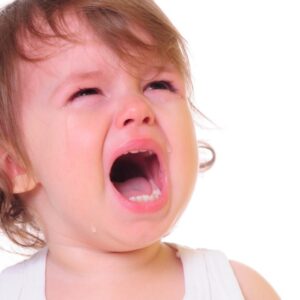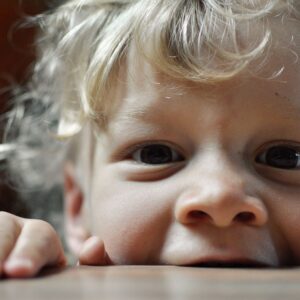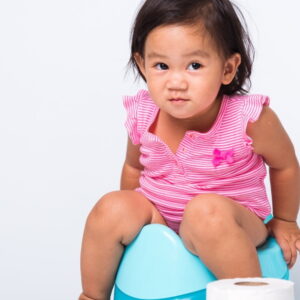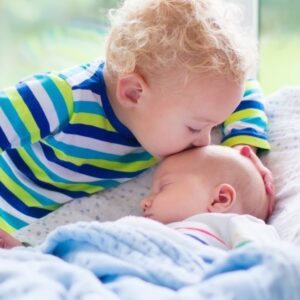There are different methods of potty training, and eventually, parents will decide which approach they consider works the best for their child. But no matter which method you use, preparing for potty training is a great step. This is true whether or not your child seems interested and ready, but for children that refuse the potty or are scared to poop, preparation is key.
In reality, how you prepare for toilet training will set the scene. Make sure it’s a positive one! Here’s how to prepare for potty training – even with a reluctant child.
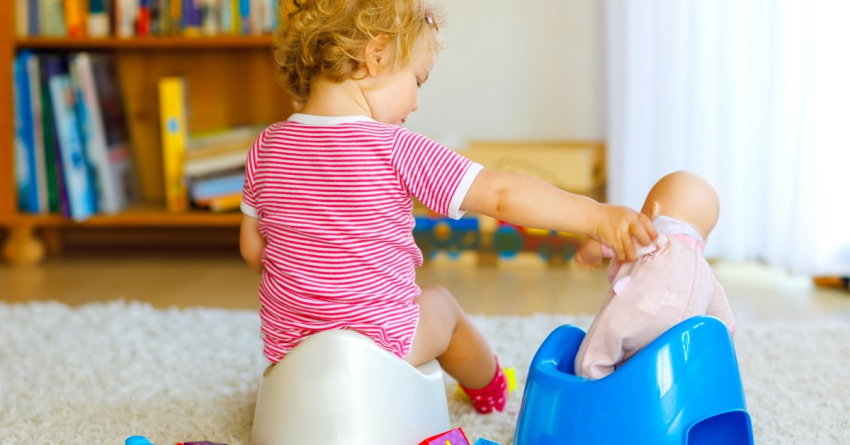
Best Ways to Prepare for Potty Training
9 Simple Tips to Prepare for Potty Training
Here are some general tips you can follow to prepare for potty training:
- You can start teaching your child about the toileting process even before they are ready for potty training by using words to describe the act of using the toilet (such as “pee,” “poop,” and “potty”), identifying behaviors (“Do you need to pee?”) to help them learn to recognize when they need to pee or poop, and talking about how pee and poop come out of the bodies
- When your child poops in the diaper, when possible, empty it in the toilet in front of your child so that you help them learn the connection between the two and explain what is happening
- Introduce the potty to the child in a casual manner and explain what it is for, or leave it where your child can see it so they may start to get curious about it
- If you (and your child!) want, practice putting your child on a potty, even in clothes or a diaper, so that they can practice sitting on the potty chair
- Don’t pressure your child to sit on the potty if the child resists
- Model the behavior by showing your child how you use the toilet and explaining what you are doing
- Read books about the potty – find some recommendations below
- Play with your child and a favorite doll or lovey that tries the potty
- Make sure to set aside enough time and prepare that the toilet-training process may require patience
- Choose a time when there are no significant changes in your child’s or your family’s routine to start potty training, especially if you want to use some quick potty training method
Helpful Potty Training Story Books
There are some good story books about potty training which start to introduce the idea and make it fun, some even come with toys and a toilet for the child to role-play, such as Potty Monkey.
Using stories is a good introduction, and you can also then gauge the level of interest the child has in learning, or become aware if there has been negative experiences around the issue. The last thing you want to do is create guilt or shame around their body, they may well have been smacked for wetting, or pooping, or been left in dirty diapers for long periods of time.
Here are some titles I would recommend:
Big Girls Use the Potty is one I like (it is quite old, but still good), as it uses real photos and rhyming text. The book also comes with reward stickers if you want to use them.
A Potty for Me is a cute little book with lift up flaps. It is quite old, but learning to use the potty is really the same process now as always. The lovely rhyming text in this book deals with the accidents (Uh-Oh!) in a positive way, and builds in affirmations which are great – I’m so proud of Me!
Dino Potty also comes with rhymes and simple, cute illustrations. So for any toddler interested in dinosaurs, this book can be an inspiration.
Some children love sound books, and there are some good ones to try. For example, Daniel Tiger’s Potty Time! is a straight forward potty training book but with three sound buttons with both flushing sounds and songs.
Having a couple of choices is quite helpful as the child can relate to them differently. Most of them come in boy and girl versions which make sense.
What not to do when potty training?
We have already mentioned some things that are a big NO when potty training your child, such as shaming or yelling. Here is the list of things you should avoid when potty training:
- Don’t start potty training during a time of stress or significant change in your child’s or your family’s life
- Do not force your child to use the potty if they are not ready, as it can create anxiety and even lead to children trying to regain control by withholding urine or bowel movements
- If your child wants to get off the potty before peeing or pooping, let them leave
- Avoid using words such as “dirty” or “stinky” to describe urine or bowel movement. Instead, use a matter-of-fact tone.
- Don’t shame, yell at, or punish your child if they aren’t successful or take a long time
- Don’t treat accidents like bad behavior
- Don’t set deadlines or have too high expectations
What if my child refuses to potty train?
Give them more time
If you have tried every approach and advice to make potty training a positive, not stressful experience for your child and your child still refuses to potty train, try not to worry . Sometimes they just need a bit more time. Try to take comfort in knowing that, sooner or later, your child will want to stay dry as much as you want them to because they won’t feel comfortable feeling wet anymore.
Helping them to learn good habits, like teeth brushing and hand washing is actually more important at than the exact timing of the potty training. If the child shows an interest, then go with their energy and encourage them, but without making a big deal out of it.
If it’s not working, it is better to avoid power struggles and stop potty training for some time. Then, return to it after a few weeks, and try again.
If they are Scared, there are books to help
Some children are afraid of using the potty. In my experience, it is more common that children resist pooping in the potty than peeing. Let them take their time! You can also try some story books that specifically target kids that are scared to use the potty, such as for example Potty Train Your Dragon: How to Potty Train Your Dragon Who Is Scared to Poop.
Let other children lead the way
Sometimes having other kids around, who are slightly older can help too, they start to see the other children using a potty, or going to the toilet, and if you have conversations about it so they understand more then they may want to copy the older child (we tend to keep toileting private and hidden).
Try a toilet insert instead of a potty
Some children prefer to use a toilet insert instead of a potty. My daughter, for example, never accepted a potty, but would gladly sit on the toilet. Just try different ways in a playful manner. You can even let them sit on your lap when you go to the bathroom and maybe sing a song together about using the potty/toilet. Just make something up!
Positive reinforcement is key
Whatever stage the child is at, you are looking to give them heaps of positive reinforcement. Potty training is not a discipline issue or something to be angry or cross with them if they make a mess. .
My thinking is that just take it very slowly, read stories to introduce the idea of using the potty, and follow their energy and developmental stage (not age).
Does elimination communication make potty training easier?
When reviewing different potty training methods, one that comes up is infant potty training. This is where parents use sounds while the baby urinates or defecates to teach the baby to pee or poop on cue. While some use this practice from birth, others start a bit later, and some use it partially.
A common question is whether this is a good way to prepare for for the “real potty training” that comes when the child is older and ready to potty train?
Elimination communication as a practice includes paying close attention and learning your baby’s signals that show they need to pee or poop. When you notice your baby needs to go, you should take them to the potty or another preferred target and use a sound or a signal for peeing and pooping. Eventually, the baby will start associating these sounds with either bladder or bowel movement.
Elimination communication’s goal is not (and at such a young age can’t be) complete potty training. When started at such an early age, this process can’t lead to your child being independent when going potty until they are older and developmentally ready.
However, if used correctly and when successful, it seems elimination communication may help you reduce or eliminate diapers at a young age, which for many parents sounds like a dream.
Another benefit of using this practice that many experts emphasize is that it helps build and strengthen the bond between the child and the parent.
Some criticize using elimination communication because it is not natural for children to pee or poop on the signal, and consider that the most natural way is with using diapers, which allow the child to urinate or defecate whenever they need, until they are developmentally ready to control their bladder and bowels.
Based on parents’ reports, in many cases, elimination communication helped their children become diaper-free at a younger age than is the case with children on average in Western Countries.
Many who used this method say it helped them in the long run because the learning process started earlier. The kids were introduced to potty and recognized what it is for at an earlier age which made the full transition to potty easier. And even though, for some, it didn’t mean they could go diaper-free until their children were older, they were happy even if the child was using the potty only a few times a day and used diapers the rest of the time.
When should I be worried or contact a doctor?
You should see a pediatrician if your child:
- Strains or experiences pain when they pee or poop
- Didn’t have bowel movements for 3 days
- Has blood in the urine or underwear
- Urinates too frequently and has sudden urges or urinates infrequently
- You may also consider talking to the doctor if your child is:
- Over 4 years old and healthy, but still hasn’t mastered daytime potty training (remember it may take longer than that in case of nighttime potty training)
- Over 5 years old and is still wetting the bed
Takeaway
Learning how to use the potty is a significant milestone for you and your child. This can be a very stressful time, but it doesn’t have to be. There are ways to make the potty training process a relatively positive experience. How you prepare for potty training will set the scene – make sure it is a positive one!
With various methods to potty train, you can choose the one you find the most helpful. But keep in mind that you can always adjust the process so that it fits your child better. Every child is different, and, as with many things in parenting, there is no one-size-fits-all when it comes to potty training. Just remember to be patient and give it time. Sooner or later, your little one will ditch the diapers forever.
Read Next
- 4 Potty Training Methods: Pros, Cons and How-to
- When to Start Potty Training (and Why!): A Scientific Approach
Research references
- Sibonney, C. (2019, May 24). Elimination communication: Can infants be actually potty trained?
- Sleeping Should Be Easy. (2020, December 17). 8 simple ways to prepare for potty training
- Development Signs in Healthy Toddlers in Different Stages of Toilet Training: Can They Help Define Readiness and Probability of Success?

Paula Dennholt founded Easy Baby Life in 2006 and has been a passionate parenting and pregnancy writer since then. Her parenting approach and writing are based on studies in cognitive-behavioral models and therapy for children and her experience as a mother and stepmother. Life as a parent has convinced her of how crucial it is to put relationships before rules. She strongly believes in positive parenting and a science-based approach.
Paula cooperates with a team of pediatricians who assist in reviewing and writing articles.


